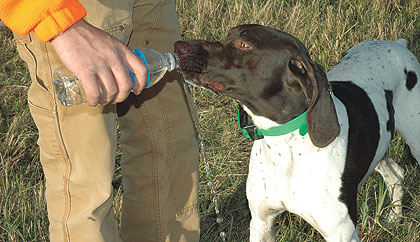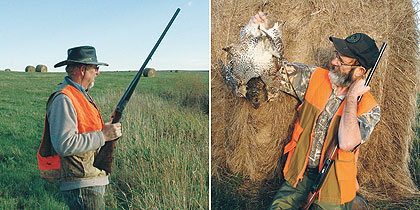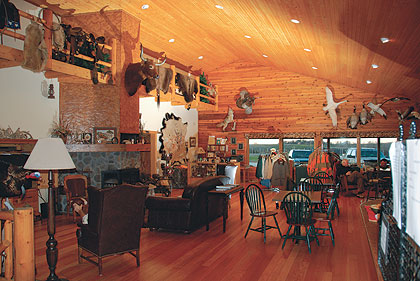The Birds Are There, But Bring Your Walkin' Boots
By Jon Wongrey
"We don't get many people who want to go after sharptails," said Phillip Mertens. "It is outright hard hunting. Maybe we'll get a shot€¦that is, at a bird in range. They are extremely smart and you can count yourself lucky if you get one. Three per man is the limit," he added.
 The German shorthaired pointer was developed in Germany in the mid-1800s for the average hunter who could not afford several specialized sporting dogs. |
Never was there anyone since Old Testament days more a prophet. It would not take me long to learn that sharptails are as much survivors as any prisoner of war.
Joe Jackson, my long-time gunning companion, and I were staying at the 2,000-acre Prairie Sky Guest and Game Ranch owned by Bruce Prins. The ranch is close to the very small town of Veblin, South Dakota, near the southern border of North Dakota.
I had come here in mid-October to hunt waterfowl and to gun for sharptails--a bird I had never hunted, a bird I knew nothing about. Sharptails were a complete mystery to me.
We would hunt ducks in the mornings with guide Sean Hammock and sharptails in the afternoons with Phillip, who works for Bruce mainly guiding hunters for released pheasants.
"A limit of pheasants we can guarantee. But not sharptails," Phillip emphasized. Phillip, 25, has the heart to attack most anything, including climbing onto the backs of raging bulls and holding on for the count or until he smacks the unforgiving ground. He has been busted up a few times. But hard work is a must in the rural West and it gives character and endurance to men like Phillip. He is a quiet young man whose face is etched with determination and a willingness to learn.
 Water breaks are frequent and critically necessary. |
The sharptail population was the highest it had been in five years. Mild winters and the Conservation Reserve Program married well. It was the same for the wild pheasant population, and the populations of both species were up.
"Sharptails seem to survive blizzard conditions better than pheasants. Pheasants are very susceptible to storms, especially longer duration storms, those of three to five days with strong winds and high snows," says Will Morlock, Regional Program Game Manager for South Dakota Fish and Parks.
Sharptails are native to the plains and have had thousands of years to adapt to rugged weather, whereas pheasants are relative newcomers, having been transplanted from China in the late 1800s.
Morlock also said that because of the Conservation Reserve Program, many tracts of marginal croplands that were planted with various grasses under the program's guidelines had now matured into established fields of grass and become excellent habitat for prairie grouse, both sharptails and prairie chickens, as well as for ducks.
Even though sharptails were hatching in greater numbers, they are not, of course, the most popular gamebirds in South Dakota and are usually shot as bonus birds during pheasant hunts. Pheasants reign supreme in this state, and they are not as physically demanding to hunt as are sharpies.
Sharptails are birds of the brush and grasslands, thriving on a variety of foods including waste grain, but they are not wholly dependent upon tilled crops. The tilled crops they eat are sorghum, wheat and soybeans. All the native plants that produce berries or seeds such as buffaloberry, rosehip and chokeberry are favored over tilled crops. Insects, grasshoppers in particular, are their main food until killed by a major freeze.
 Joe Jackson prepares to walk through another prairie bottom in hopes of flushing a sharpie (right). The author did not drive for almost three days to hunt anything but wild. These three grouse, not counting the single bird taken on the first afternoon of hunting, were the culmination of hard hunting. The reward was worth the pain.(left) |
It was on that first afternoon sharptail hunt that I met Hunter and Spot, two German shorthaired pointers initially trained by Tom Dokken of Oak Ridge Kennels in Northfield, Minne-sota. Tom is also the originator of Dokken's Dead Fowl Training Dummy.
The shorthair was developed in Germany in the mid-1800s for the average hunter who could not afford several specialized sporting dogs. The German sportsman needed one all-purpose hunting dog with a good nose, obedient and reliable at water retrieving.
Several German, and perhaps French, scenthounds were crossed with Spanish pointers. The results were then further refined by crossing with pointers from England. By 1911 the breed was standardized and its fame spread, meeting many sportsmen's requirements for hunting both upland game and waterfowl. The first German shorthaired pointers arrived in the United States in the 1920s and by 1930 the breed was recognized by the American Kennel Club.
We had been walking for over an hour at a steady pace, cresting one hill after another, and had not seen nor flushed a grouse. Our trek brought us to a small, long abandoned wooden prairie house now in shambles and I could not help wondering at the fortitude of the men and women who lived in such homes in the prairie loneliness and through the region's long, bitter winters.
We hunted our way back to the truck and made a short run to where Phillip had seen grouse on an earlier recon. There, he pointed out six sharptails in the middle of a cut soybean field.
 Phillip Mertens, left, and the author move up on what they hope is a point. German shorthairs are more of a foot dog than far-ranging pointers or English setters. |
"Maybe there are some in the bottom we could flush," he said and put down a fresh dog.
With Joe on the left, Phillip in the center, myself on the right and a working shorthair out front, we began our push through the bottom and jumped a sharptail at about 50 yards. Joe got off two shots but did not fluff a feather and we watched as the bird sailed beyond what seemed to be the curve of the earth.
We continued on in the bottom, flushing yet another bird, which Joe killed, giving us one in hand. We hunted on to near dark without any more flushes or shots. We returned to the ranch.
"The German shorthair is a closer working dog by breeding and training--more of a foot dog," said Tom Dokken during a brief interview at the ranch. "We usually start them at five months by introducing them to the gun and we begin training with ducks and pheasants. But mostly we use pigeons because the pups' mouths are still small. "Then we get them back at eight to 10 months for 90 days to teach them on and off the leash and steady them to wing and shot. We also teach force fetching and break them to the whistle. And at all times we make training for these youngsters as much fun as we can.
"But while getting a trained dog is the end product, it is more about breeding," Dokken continued. "Look for bloodline, bloodline. If you're going to roll the dice, then toss it with good material. Spend as much money as you can afford.
 The ranch's social room reflects the South Dakota lifestyle. |
"But also understand that there is no magic to getting a well-disciplined dog. To become a great athlete, you must train, train and train. Personally, I like to start with a shorthair that has a solid field trial background in its breeding. This seems to jump start the program.
"You've got to stimulate the dog to get the full package. But this isn't as hard as it once was, simply because training equipment has improved and you have more people in the sport who readily exchange information.
"In field trials the game is about ribbons and awards. With the hunting dog it is about finding birds and doing it in a manner that gives success to the hunter.
"Again, you must have a strong fundamental base when training. No two days are alike. You want a great dog, not a marginal dog. This is especially necessary if you don't hunt much. Never let a dog take control of the hunt.
"If you do, then you've got an ill-trained animal. German shorthairs are extremely intelligent dogs. They are a quick study," Dokken concluded.
On our second afternoon of sharptail hunting, the wind was much stronger than on the early morning duck marsh, and it beat us relentlessly as we mounted the prairie hills and marched through the bottoms hoping to raise feathers.
The afternoon passed without firing a shot and maybe flushing a dozen or so birds at eyesight's limit. I had yet to pull the trigger. Only one afternoon remained to hunt these evasive sharptails.
Those who had hunted pheasants had gotten their limits at the ranch and were bathed and dressed for supper when we trudged in worn to the marrow.
But I wanted wild. I did not travel by car for almost three days to hunt anything less than the undomesticated. Sharptail hunting is hunting in its purest form. Stamina is the key to chasing these birds and Phillip's iron will matched Joe's doggedness and mine.
The third and final afternoon hunt for sharptails was without a whisper of wind, and the thermometer had climbed into the high 60s. I went out in a short-sleeved shirt. For a while it seemed that our sharptail adventure was going to wind up a massive failure until late afternoon when the shorthairs found them.
Joe knocked down and picked up two birds. And as night was about to shutter day, I rolled my first and only sharptail.
If You Want to Go€¦
For more information, contact Prairie Sky Guest and Game Ranch, 109th St., Veblin, SD 57270; (605) 738-2412 or fax (605) 738-2412. Their website address is www.priarieskyranch.com and email is info@prairieskyranch.com.






